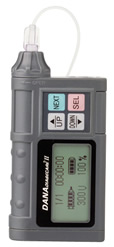The Dana Diabecare IIS is an insulin pump developed by SOOIL Development, a South Korean company with over 46 years of expertise in insulin pump innovation. This compact and lightweight pump is used by over 50,000 patients across 47 countries and offers reliable insulin delivery for diabetes management.
Key Features of the Dana Diabecare IIS
🏆 Compact & Lightweight Design
The Dana Diabecare IIS is one of the smallest and lightest insulin pumps available, making it ideal for users looking for discreet and comfortable insulin therapy.
🔄 User-Friendly Interface
- Icon-based menu system for easy navigation
- Supports 24 languages for accessibility worldwide
- Simple programming for quick insulin adjustments
💉 Flexible Insulin Delivery
- Basal and bolus customization for precise control
- Extended & dual bolus options for better meal management
- Carbohydrate-counting bolus calculator
💲 Affordable Insulin Pump
- More cost-effective than many leading insulin pumps
- Lower price point makes it an attractive option for self-funded users
Waterproof Design
- IPX8 waterproof rating for daily activities
- Reliable in humid environments or accidental water exposure
Dana Diabecare IIS Technical Specifications
🛠 General Specifications
- Size: 75 x 45 x 19 mm
- Weight: 51 grams (without battery)
- Insulin Reservoir Capacity: 300 units (3.0 mL)
- Battery: Single 3.6V lithium battery (lasts 4–6 weeks)
🔢 Memory Storage
- Previous 500 bolus doses
- 500 priming volumes & total daily insulin records
- 100 alarm records with timestamps
🔄 Basal Rate Settings
- Range: 0.04 to 1.67 units/hour (adjustable up to 8.0 U/hr in lock-out mode)
- Increments: 0.01 or 0.1 units per hour
- Total Basal Settings: Up to 24 changes per day
💉 Bolus Delivery Options
- Bolus Range: 1.0 to 40 units (adjustable up to 80 U in lock-out mode)
- Increments: 0.1, 0.5, or 1.0 units
- Delivery Speed: 10 seconds per unit
Comparison: Dana Diabecare IIS vs. Other Insulin Pumps
| Feature | Dana Diabecare IIS | Medtronic 780G | Tandem t:slim X2 | Omnipod 5 |
|---|---|---|---|---|
| Size & Weight | Compact & Lightweight | Larger, bulkier | Slim | Tubeless, patch-style |
| Insulin Capacity | 300 units | 300 units | 300 units | 200 units |
| Tubing | Yes | Yes | Yes | No |
| Automated Insulin Delivery | ❌ No | ✅ Yes | ✅ Yes | ✅ Yes |
| CGM Integration | ❌ No | ✅ Yes (Guardian 4) | ✅ Yes (Dexcom G6/G7) | ✅ Yes (Dexcom G6) |
| Waterproof Rating | IPX8 | IPX8 | IP67 | IP28 |
| Battery Life | 4-6 weeks | Rechargeable | Rechargeable | Internal (3 days) |
| Smartphone App Control | ❌ No | ✅ Yes | ✅ Yes | ✅ Yes |
🔍 Who Should Choose the Dana Diabecare IIS?
✔️ Users who prefer a simple, traditional insulin pump
✔️ Those looking for an affordable insulin pump option
✔️ People who don’t need CGM integration or automated insulin delivery
✔️ Frequent travelers who want long battery life
⚠️ Who Should Consider Other Pumps?
❌ People who want automated insulin adjustments → Consider Medtronic 780G or Tandem t:slim X2
❌ Users who prefer tubeless designs → Try Omnipod 5
Safety Information & Warnings
Intended Use:
The Dana Diabecare IIS is designed for subcutaneous insulin delivery to manage diabetes mellitus. It should not be used with blood or blood products.
Contraindications:
🚨 Not recommended for individuals with impaired vision or hearing who cannot recognize alarms.
Warnings:
⚠️ Users must receive training from a certified diabetes educator or insulin pump trainer.
⚠️ Regular blood glucose testing (minimum 4 times/day) is required.
⚠️ Only use with compatible infusion sets, reservoirs, and accessories.
Using the Dana Diabecare IIS with DIY Automated Insulin Delivery Systems
While the Dana Diabecare IIS does not feature built-in automated insulin delivery (AID) like the Tandem t:slim X2 with Control-IQ or Medtronic 780G, it is one of the few pumps that can be integrated with Do-It-Yourself (DIY) AID systems like AndroidAPS and Loop. These open-source systems allow users to create a hybrid closed-loop setup by connecting the pump with a compatible Continuous Glucose Monitor (CGM), such as the Dexcom G6/G7 or Freestyle Libre (via third-party apps). This setup enables automated basal rate adjustments and bolus recommendations based on real-time glucose data. However, users considering this approach should be well-versed in DIY diabetes technology, as it requires manual configuration, troubleshooting, and a strong understanding of insulin management. DIY AID systems are not FDA-approved, but they provide a valuable option for experienced users seeking greater control over their diabetes management.
Final Thoughts: Is the Dana Diabecare IIS Right for You?
The Dana Diabecare IIS is an excellent option for users looking for a simple, reliable, cost-effective insulin pump. While it lacks advanced features like CGM integration and automated insulin delivery, it remains a practical choice for those who prefer manual control over their insulin therapy.
📌 Interested in learning more? Visit the official Sooil USA website for details on the product.

